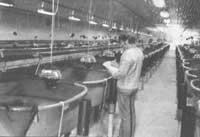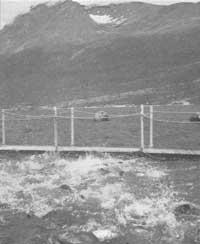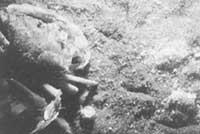Threat of salmon in nursery

Norway is not a backward state in salmon farming. The goal of this country is that both the cold waters of Finnmark in the Archaic Circle and the fish able to live in warmer waters of Rogaland at 1,000 km south grow in baskets. The ideal salmon they want to achieve would be able to live in the same basket with hundreds of similar fish (at the same time), anticipate diseases and grow rapidly, turning what they eat into a suitable balance between meat and fat. It will not sexually reach the size of killing and selling. Norway has the salmon prototype that is transforming the local salmon farming industry.
Salmon lovers find it difficult to distinguish in fish what characteristics are hereditary and what effects they have on the environment, but gradually try to get a fish with the genetic uniformity they want.
Norway is the only state to have a salmon breeding program so far. They have produced fast growing fish, which is a breakthrough for those engaged in fishing. Each year the new generation of salmon grows 10 to 12 percent faster than the previous one. This program has also given a great boost to the fishing industry. Five years ago, 17,000 tons of salmon were produced in Norway, a production of 80,000 tons is expected this year. As you can see, the difference is not joking.
Salmon farming is also good news for the state treasury. More than 90 percent of the farm's salmon and rainbow trout is exported. However, the progress of the industry worries conservationists about the future of Norwegian Atlantic Petroleum. This concern is because more and more salmon escape from the sea baskets to the rivers of Norway. The hermitage is located on the river around 400. The salmon populations of each river are genetically different. In a river there may be two or three different populations, each with eggs in a certain area of the river.

Upon reaching the river, the escaped salmon have to compete with the pots, on the one hand to get scarce food and on the other to get egg-laying areas. Importing contaminated eggs or salmon pups, for example, diseases transmitted to fish from fish farms could be completely new to the vessel.
According to the latest statistics on commercial fishing in Norway, 20% of this year's catches have escaped nurseries. According to the records made to know the amount of salmon escaped from fish farms in the rivers of Norway, the closer the river of the fish farm is, the greater the invasion of fish and that in some and other rivers this invasion is not the same size.
Nursery salmon and the false forest live in different conditions. Atlantic salmon lays its eggs in fresh water, where it stays for at least a year and can sometimes stay for up to 8 years. These young fish grown in fresh waters are known as “Planets”. In the next step of their life cycle, these young salmon migrate to the sea to feed and mature, but before they undergo behavioral and physiological changes to live in the marine environment. They develop separate chloride cells in their gills to actively excrete sodium salts.
These cells reproduce before migration. The kidneys barely produce urine and fish drink more water to compensate for the dehydrating effects of salt water. The pigments of the retina are modified to be able to observe them in the bluer marine water. Their blue-gray body clues wear out and the fish becomes bright gray. At this level they are known as “smolt”.

The so-called “smolt” can travel thousands of kilometers in the sea to find food areas. Most of them remain at sea two or three winters and some remain five years. Then, with exceptional precision, they make a long journey back to the ancient river to spawn. When they reach the fresh waters they stop feeding and can travel more than 30 kilometers a day crossing waterfalls and other obstacles to reach the areas of laying eggs, where the rivers are born.
Regulated life
The selection criterion used today is that of spending little time growing and resisting disease. Salmon lovers choose a fish that will come late to maturity, thus directing this animal to produce its own meat (and not its eggs or sperm). The quality and color of meat are also important in the choice of potential parents.
Each year, from two breeding centers, young salmon from 150 families, called “Smolt”, are sent to five research centers located in different places in Norway. These last centers have different environmental conditions (water temperature, daylight hours, etc.) for being elected. Fish are fed for two years and researchers can analyze various factors, such as birth time and mortality at different ages. Based on the results obtained, biologists choose the largest fish of every ten production families of the year to be parents of the next generation of salmon. The process that has followed each fish since the beginning of the reproductive program has led salmon fans to discover the genealogy of the selected fish and thus avoid inbreeding.
In this way, the farm fish is selected taking into account the characteristics of commercial importance. In 1987 it was the fourth generation artificially selected. In breeding centers they grow to be smolt or young salmon and distribute more than 200 million to fish farms throughout Norway.

In marine baskets they are given concentrated food to obtain a good weight and size fish. Antibiotics and fungicides are given to treat bacterial diseases and fungal infections. Behavior in the territory is disappearing. It seems that the fish that started making artificial selection is not the same as the current one. The current one is not scared like the previous one when man approaches them. It is not aggressive. But salmon lovers still don't know if these changes are behavioral or genetic.
According to experts in the field, those who escape the nurseries in the last phase of life (after feeding in the sea) return to the vicinity of the marine basket, but lose the precision that characterizes the vaseline. Consequently, the eggs return to the rivers to spawn, but in November without order. Salmon biologists don’t know exactly what salmon are used to return to their “home.” According to experts, this “return” is based on the sequential inprinting of the sensory signals that young salmon receive when they leave the river.
Odors, views, water temperature and other sensory indicators can be combined to produce this imprinting. According to biologists, young “smolt” or salmon receive these keys or signals as a video camera, and then watch them backwards when the time comes to return to their birth. Fish from the fish factory does not have the possibility of this sequential imprinting, so those who escape in the final phase of their life are not “domestic” when they return from the sea to a specific river.
The fish prototype is not the only threat that vasaline can have. The Norwegian savage has already suffered the attack of the parasite Gyrodactilus Salaris. It first appeared in fish farms and since then has almost completely disappeared some fish banks. It is believed to have been imported from a contaminated nursery in Sweden. It first appeared in 1975, the year in which the salmon pups “Sun” of the Lakselva River appeared completely contaminated. By 1982 the parasite spread to seven other rivers and according to the last count there are 33 polluted rivers.

The parasite is not a problem for salmon lovers (from salmon farms), since with a little formalin (40% formaldehyde) in the water tank the parasite is finished. The only solution for Basaizokina is the extraction and treatment of contaminated fish, the treatment of the entire river by applying a powerful poison called rotenone and the replenishment of healthy fish. This procedure, however, is expensive and not suitable for all rivers.
Acid rain and snow have also caused damage. In the south and west, in areas affected by acid rains, 25 fish banks have disappeared or are in danger of extinction. And along with all this, we have a fishing without measures, both in the Norwegian commercial fisheries and in the fisheries of Greenland and Faeroes.
Meanwhile, the fish industry is booming. Last year Norway produced a surplus of young “Smolt” salmon of about 6 million. Salmon lovers want to throw this surplus into the sea and then, upon returning to its former place, capture it.
This practice would only increase the pressure endured by small fish banks as a result of commercial fishing.
The risk of crossing fish from fish farms with local fish banks seems more important for the future. Crossing with wild populations can lead to genetic uniformity that exceeds farm fish.

Numerous biologists have worked on the study of genetic diversification of fish and wild fish in farms, addressing changes in the chemical composition of some proteins.
Because fish banks can have different forms of the same protein, biologists (if they opt for a relatively large group of protein markers) can make a statistical view of the variation between the different banks. The schools of the same river, which lay eggs in different areas, are genetically different.
The Norwegian playback program selects commercial value features. Currently, the program avoids the crossing of production fish other than the same year, which would make them even more uniform.
The presence of small fish banks in many Norwegian rivers makes vaseline vulnerable to genetic changes.
Salmon lovers, if necessary, would never have where to go in search of fresh genetic material to find new features. Fortunately, faced with this problem, in 1986 a sperm bank was put for the fish banks. Currently, the bank has sperm samples of 857 salmon of 69 Sardinians.

So far, scientists have found 17 genetically modifiable points on salmon chromosomes. In other words, there could be 17 differences between networks. According to the study, these genetic marks are probably not the result of the month of November, but the result of natural selection. Thus, it can be thought that these marks are significant for the thistle to remain in the same river.
Despite the potential pernicious effects of genetic erosion and the increasing number of fish escaped in rivers, the interaction between fish from the fish factory and wildlife has been limited. Biologists see danger, but have not yet found concrete data on the subject.
One of the measures that can be taken in the future is for farm fish to be sterile.
Scotland, which expects to reach 54,000 tons of fish by 1990, is the country with the highest production after Norway. While local authorities count the benefits of the 1,100 new Highlands jobs, others, conservationists, are concerned about salmon farming, as there is no legal control plan for this industry. And scientists are also concerned about the impact that the rapid expansion of such industries can have on the marine environment, in the fresh water environment and in the wild. Each basket can contain many tons of fish and must be fed. By 1990 the Scottish industry will consume 184,000 tons of eel, gypsy sardine and other dams and seabirds. Sandy, dried and pill compressed eels are less nutritious than fresh eels, so each pill contains 15 vitamins, 11 minerals and a synthetic dye (E161g) as additives. This dye (prohibited in the USA) transforms fish meat from the nursery into pink grey, like wild meat. Fish and baskets are preserved by chlorine, sodium hydroxide, iodine (iodine solution) and calcium oxide. Formaldehyde, green malachite and four common antibiotics are used to keep the disease away. Scientists from the Nature Conservation Council (NCC) and Stirling University have analyzed the impact of pollution on salmon baskets. Of 10 tons of food, a ton of waste goes to the bottom of the sea and a half ton (as soluble nitrogen compounds) is introduced into the water column. To metabolize these additional substances, seabed sediments around baskets and microscopic organisms living in charge of this sediment need more oxygen. When oxygen is exhausted, organisms are destroyed, often replaced by the uniform growth of bacteria called Beggiate. Also, due to the presence of these additional nitrates, algae multiply in the water column. When algae disappear, the bacteria that destroy them multiply and consume more oxygen from the water. And worse for salmon: some of the algae that form are poisonous to fish. In all countries where salmon grows, either because farm salmon has escaped from the basket, or because salmon lovers intentionally release them, or because they fill the rivers with salmon from freshwater farms, they mingle with Vasalines and scientists increasingly realize the threat posed by fugues for Vasconine, short-term (obtaining food) and long-term characteristics. According to the Scottish Salmon Breeding Association, the number of escapees is low, but reality contradicts it. In 1987, fish biologist Peter Maitland counted 90,000 fish as escaped. That same year, a support group for the Atlantic Salmon Recovery in America estimated that an average 15 percent of the nurseries fled. In Scotland, no one has accurate data to know how much is poured into the sea in “smolt” and “contrast.” |





